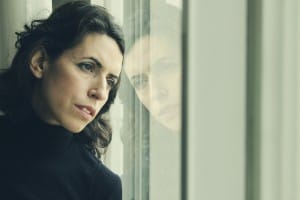In the U.S., women have a much higher chance than men of developing depression. This increased risk applies to the severe illness known as major depression and includes certain forms of depression unique to women. In a new study published in the Archives of Women’s Mental Health, researchers from the University of Pittsburgh sought to determine how much a family history of major depression increases a middle-aged woman’s chances of developing symptoms of this potentially debilitating disorder.
Major Depression
Roughly 6.7 percent of American adults have diagnosable cases of major depressive disorder, the National Institute of Mental Health reports. This rate of exposure marks major depression as one of the nation’s most common mental health challenges. A person affected by the disorder has severe forms of depression symptoms such as a recurrent or continually anxious, sad, hopeless, helpless or guilty state of mind; a reduced ability to gain pleasure from previously enjoyed activities; an unusually restless, agitated or irritable state of mind; declining energy levels; problems with memory, focus or other core mental faculties; changes in sleeping or eating patterns; unusual aches or pains and suicide-oriented thoughts or behavior. Some combination of these symptoms must appear for at least one episode lasting two weeks or more; affected individuals may also experience recurring bouts of depression. In addition to being female, known risks for developing major depression include having a European-American racial/ethnic background and being a young adult in your late 20s or early 30s. However, adults from all sorts of demographic backgrounds experience diagnosable symptoms of the disorder. Roughly 3 percent of U.S. teenagers also have symptoms of major depression or some other damaging form of depressive illness.
Women and Depression
The average woman has an approximately 70 percent greater chance of developing some sort of diagnosable depression than the average man. Part of this elevated risk is related to changes that occur in women’s bodies during monthly menstruation and during and after pregnancy. The American Psychiatric Association officially recognizes a depressive disorder, known as premenstrual dysphoric disorder, associated with the hormonal changes that characterize the menstruation process. Another gender-specific form of depression, postpartum depression, can appear in the days or weeks following the birth of a child. In addition to hormonal and chemical changes, acknowledged underlying factors that at least partially account for women’s increased depression risks include genetic predisposition (i.e. family history) and gender-specific reactions to stressful, highly traumatic or life-threatening events.
Influence of Family History
In the study published in the Archives of Women’s Mental Health, the University of Pittsburgh researchers used data from two projects—the Women’s Mental Health Study and the Study of Women’s Health Across the Nation—to help determine the role that a family history of major depression plays in increasing the depression risks for middle-aged women. A total of 303 participants from these projects were included; all of the included women were between the ages of 42 and 52 and had an African American or European American racial/ethnic background. Each participant submitted a family history of depression and other mental health issues. The researchers used criteria drawn from the American Psychiatric Association’s Diagnostic and Statistical Manual of Mental Health (DSM) to gauge each woman’s current exposure to major depression. The researchers concluded that middle-aged women with a family history of major depression have a roughly 200 percent higher chance of experiencing diagnosable major depression than women with no such family history. This fact holds true even when a range of other factors capable of contributing to depression risks are taken into consideration. Examples of these additional factors include experiencing depression symptoms before reaching middle age, having an unusually anxious personality, having a history of exposure to traumatic events and having a history of chronic physical health problems. The researchers also concluded that midlife major depression risks reach their peak among women who experienced depression symptoms at any point in earlier life. The study’s authors note that a family history of major depression clearly increases the odds that any middle-aged woman will develop the disorder, regardless of her prior personal depression history. However, they also note that a prior personal history of major depression clearly boosts the odds that a middle-aged woman will develop major depression.



